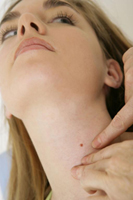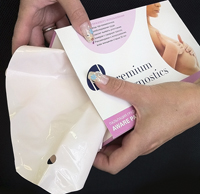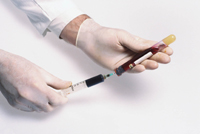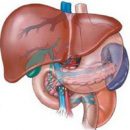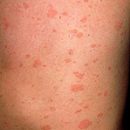Hodgkin's disease, lymphogranulomatosis, malignant lymphoma - all this name of one dangerous disease. It sounds threatening, but statistics consults - the percentage of healing higher and higher. All you need to know about lymphogranulomatosis - read the article.
Content
Lymphogranulomatosis, also called Hodgkin's lymph or Hodgkin's disease - view of a malignant tumor, which develops from lymphatic tissue, including lymph nodes and other organs that constitute part of the body's protective system (spleen, forkry gland, bone marrow).
Hodgkin's disease (the most common name of lymphogranuloseza) was named after Thomas Hodgkin, who first described it in 1832. Since the lymphatic fabric is available in many parts of the body, the Hodgkin's disease can also occur almost everywhere. The disease leads to an increase in lymph nodes and squeezing nearby tissues and organs. Tumor cells can spread through lymphatic or blood vessels in any part of the body.
This disease, alas, not rare. In 2002, 3377 cases of lymphogranuluitosis in adults were diagnosed in Russia. In 2004, about 7,600 people got into the United States and died about 1320 patients. These are the numbers. Although due to the success of treatment, mortality from Hodgkin's disease decreased more than twice as compared with the beginning of the 70s.
Hodgkin's disease may occur both in children and in adults, but most often it is revealed in two age groups: at a young age (from 15 to 40 years old) and older (after 55 years).
And although the causes of Hodgkin's disease today are not clarified, there are still some risk factors that can contribute to its occurrence:
- in patients undergoing infectious mononucleosis;
- In patients with a depressed immune system (for example, AIDS-syndrome of the acquired immunodeficiency) and after transferred transplantation of organs.
But it is not necessary to despair, medicine does not stand still and are currently being studied to clarify the causes of this disease.
On time to recognize the disease - the first step towards victory over it
The reasons to the end are not clarified, but the symptoms of the disease are quite known, the main thing to see them.
Lymphogranulomatosis is standardly manifested by an increase in lymph nodes mainly in the neck area, less often - in other places, the spleen increases, the body temperature is kept in the area 38 and more degrees during several weeks or months, there is a strong exhausting sweating, especially at night, while sleeping, sharp Miscellaneous, accompanied by weakness, pale skin color and sometimes itching, decreased appetite and general male.
 Increased lymph nodes do not hurt and practically do not bother. Only if the increase in lymph nodes occurred in the chest cavity, this may cause trachea compression, which is often accompanied by coughing and shortness of breath.
Increased lymph nodes do not hurt and practically do not bother. Only if the increase in lymph nodes occurred in the chest cavity, this may cause trachea compression, which is often accompanied by coughing and shortness of breath.
Most patients and years have been carrying a tennis ball on her neck or armpit, it gradually increases. In fact, this ball, mandarin or apple, before was less than pea - painless elastic lymphatic knot. This is a call, rubbing in consciousness, infinitely turned off by the patient. To sleep further, do not get up to work or study, do not go to the doctor. To the doctor go scary and this visit is infinitely postponed, while it becomes impossible to seem topless in the company of friends, or the shoulder ceases to cut freely to the chest, or in the groin the node grows until indecent. You can watch and not see. And mom and grandmother feed in the morning breakfast son sitting without shirts. It is clear that he looks at himself in the mirror and does not want to think about a neoplary that grows slowly, damaging internal organs, and in the end leads to death. But relatives are obliged not only to watch, but also see, say and bring their loved one to the doctor.
Therefore, when the listed symptoms appear, you need to urgently consult a doctor and conduct a survey. Although these symptoms may be with other diseases, but it is better not to risk.
The first step is a complete medical examination and a thorough examination to eliminate infection. During the examination, the doctor will pay special attention to the condition of lymph nodes. Given the fact that most people have, especially in children, an increase in lymph nodes is often associated with infection, the doctor may assign antibiotics to reduce the size of these nodes. If the positive effect of such treatment is not noted, then further examination is necessary.
The only method of confirmation of the diagnosis of lymphoganululetosis or Hodgkin's disease is biopsy, t.E. Taking a tumor tumor piece for research. To do this, in some cases, it is necessary to remove the lymphatic node of the whole or a small part of it. Specialist explores the resulting material under the microscope. Sometimes the primary biopsy does not allow to confirm the diagnosis and the need to perform re-biopsy arises. Be ready for it and do not be afraid.
Stages of the disease
The determination of the stage of the disease (the degree of dissemination of the process) is a very important point, t.To. From this largely depends the choice of treatment and disease forecast.
Distinguish between four stages of the disease (with i to iv). How they do? After confirmation of the diagnosis of Hodgkin's disease, the stage of the disease is specified using X-ray examination, ultrasound, computed tomography, magnetic resonance imaging and other modern methods. They help to identify other tumor foci, possibly not seen earlier.
Ways to healing
There is a reason for optimism - in recent years, significant results have been achieved in the treatment of Hodgkin's disease. The purpose of treatment, as doctors say, is a complete cure. According to statistics, approximately 90% of patients are cured with chemotherapy and irradiation.
After clarifying the stage of the disease, you need to make a decision and choose optimal treatment. It is necessary to think about all possible options. When prescribing treatment, everything is taken into account - age, general condition, tumor type and medical stage. It is also important to know about risk and complications of treatment (alas, not without it).
So, there are two main methods of treatment of lymphogranulumatosis: chemotherapy (the use of drugs destroying tumor cells) and irradiation (the use of high-energy X-rays in order to death tumor cells or reduce tumor sizes). Sometimes apply one type of treatment, sometimes, in some cases, both.
At the same time, highly visible chemotherapy with bone marrow transplant is used only in exceptional cases in the inefficiency of other methods of treatment. And the surgical method has only an auxiliary role in the treatment of patients with lymphogranulomatosis.
And now in more detail.
Chemotherapy
 Under chemotherapy implies the use of antitumor drugs, destroying tumor cells. Typically, such drugs are prescribed inside or in Vienna. Often during treatment several drugs are used simultaneously.
Under chemotherapy implies the use of antitumor drugs, destroying tumor cells. Typically, such drugs are prescribed inside or in Vienna. Often during treatment several drugs are used simultaneously.
However, you need to know that antitumor drugs by destroying tumor cells also damage the normal cells of the body and can cause complications. These complications depend on the type and dose of drugs, as well as the duration of treatment. These include: baldness, ulcers in the oral cavity, increasing the frequency of infectious diseases, increased bleeding, bleeding, fatigue, loss of appetite, nausea and vomiting. But fortunately, these complications are temporary and pass after the cessation of treatment, and special drugs exist to prevent nausea and vomit.
However, some drugs can lead to side effects and after discontinuation of treatment, even after a long time. They can concern heart, lungs, growth, childbearing. The likelihood of the second tumor is also not excluded. These problems must necessarily discuss with the doctor before the start of treatment.
Radiation therapy
Under radiation therapy implies the use of high-energy X-rays in order to destroy tumor cells.
Radiation therapy is usually assigned after 3-6 chemotherapy courses. Exposure can also cause serious complications, for example, damage to those surrounding healthy fabrics in the form of leather redness, fatigue, liquid stool. In patients, as in the previous case, and late complications.
Highly visible chemotherapy with bone marrow transplantation
Sometimes standard therapy does not allow you to treat Hodgkin's disease, in connection with which the patient is offered another type of treatment. In this case, to destroy stable tumor cells to standard chemotherapy, high doses of chemotherapy products are used, affecting not only tumor cells, but also on healthy blood cells and bone marrow. Therefore, pre-harvested and preserved bone marrow cells through a vein are returned to the patient.
Another type of transplantation is the so-called peripheral stem cell transplantation. In this case, the special apparatus selects only stem (immature) cells from the blood of the patient. The rest of the blood returns back to the patient. This procedure usually takes several hours. Stem cells are then frozen and returned to the patient after the completion of treatment.
It is believed that the implementation of the above procedures is better to conduct in an earlier period of the disease, and not when the tumor spread too far. If during primary treatment failed to completely get rid of the tumor, then doctors can recommend transplantation.
Hodgkin's disease in children
Although, in general, the treatment of Hodgkin's disease in adults and children is equally, however, there are some differences. In the event that the child is quite an adult, then its treatment is not much different from that in an adult patient. If the child is in the stage of active growth, then it is more often prescribed chemotherapy than irradiation, because radiation therapy may adversely affect the growth of bones and muscles. The purpose of the treatment of children is more complicated - complete cure without remote consequences. And fortunately it is. Full cure Children with lymphogranulomatosis are achieved in 85-100% of cases, including patients with a common process.
As mentioned earlier, the treatment of lymphoganululetosis is now, in most cases, effectively. According to the United States, the relative survival rate after 1 year after treatment is 93%, and 5- and 10-year survival - 82% and 72%, respectively. By 15 years, the total survival rate is 63%.
All depends, of course, on the degree of dissemination of the process. Thus, at the I stage of Hodgkin's disease, the relative survival rate is 90-95%, at II - 90-95%, at III - 85-90% and at IV - about 80%. Many patients live more than 5 years. And the results continue to improve due to the constant improvement of treatment.
Treatment is completed - what ahead
Unfortunately, every type of treatment of Hodgkin's disease is accompanied by complications. Some of them can be permanent, for example, loss of ability to fertilize. But, as they say, warned - it means armed, and if you know about possible complications in advance, you can speed up the process of recovery and reduce their severity.
The main thing is to remember that each organism is unique, including unequal reactions to treatment and emotions. Thus, the same tumor diseases differ in different patients and no one may foresee how a particular patient will react to one or another type of treatment. After all, a person can have a preserved immune system, a healthy food culture, excellent support from family members and a strong faith in itself, which will help him overcome all obstacles and overcome the disease.
But the treatment of disease is not limited to the treatment of disease, it is necessary to be attentive to themselves after treatment. Monitoring patients with lymphogranulomatosis after the end of treatment is a very important point. The doctor will explain what studies and how often must be carried out, including blood tests, an X-ray study of the chest, computed tomography and other methods in order to identify remote side effects and complications, as well as early detection of recurrence (return) of the disease.
A good fact is that most patients with Hodgkin's disease are fully cured. However, as already mentioned earlier, many years after the end of therapy, serious side effects and complications of various severity may occur in patients. The most serious complication may be the occurrence of the second tumor. And also, some chemotherapy requirements or their combination with irradiation increase the risk of developing acute leukemia after treatment.
Other types of tumors associated with radiation therapy may occur. For example, young women (up to 30 years) who received radiation therapy on the chest area have a rather high risk of developing breast cancer a few years after the completion of irradiation. Such women should be carefully observed and examined on the subject of early detection of breast cancer. They are recommended to perform mammography, clinical examination and self-examination of the mammary glands. Both men and women who received radiation therapy on the chest area also have an increased risk of a lung and thyroid cancer. And although there are no accepted screening programs for lung and thyroid cancer, this category of patients is subject to frequent inspection and examination. It should also be remembered that the risk of developing malignant tumors is higher in smoking patients who were treated for Hodgkin's disease.
A less serious, but important problem associated with side effects of chemotherapy and irradiation is infertility. Men often lose their ability to produce cum. Usually this process is restored, but not always. In women, after the treatment of chemotherapy, the process of ovulation and menstruation may also cease. After the cessation of treatment, these processes can recover, but may not come to the norm. And radiation therapy on the ovarian region generally causes a persistent sterilization, unless the ovaries were surgically removed from the irradiation zone. Sad.
Another problem is the fight against infections. Since the immune system of patients with lymphogranulomatosis does not function normally, such people should pay attention to the prevention of infectious diseases, will have to make vaccinations, including flu vaccinations. In addition, about any infection, they must immediately receive appropriate treatment.
In the process of antitumor treatment, thyroid gland and heart can be damaged. Many people who have suffered irradiation on the field of the thyroid gland arises insufficient production of thyroid hormones. Therefore, such patients need substitution therapy. The function of the thyroid gland should be examined at least annually. Heart region exposure can damage arteries with oxygen heart muscle. In people who received radiation therapy on the chest, increased the risk of heart problems. This patient is not recommended to smoke and should be observed a diet aimed at reducing the risk of heart problems.
All people who have undergone treatment about Hodgkin's disease must for many years and even decades are under thorough observation of doctors, fulfill their recommendations and immediately report the symptoms that appeared.
Treatment of Hodgkin's disease, as we already know, aimed at the destruction of all signs of the tumor. However, if only partial effect is achieved, it is necessary to provide for the possibility of applying another type of therapy, for example, bone marrow transplantation. After all, no one is insured against recurrence (return) disease.
If the recurrence of Hodgkin's disease still manifested itself (even after a long period of time), further treatment is inevitable. Depend on it will be on the therapy that the patient received earlier. For example, if chemotherapy was used earlier in the treatment, you can try to assign other chemotherapy. If the radiation therapy was used on a certain area, then the re-exposure on the same area is no longer appointed. Need to look for other solutions.



